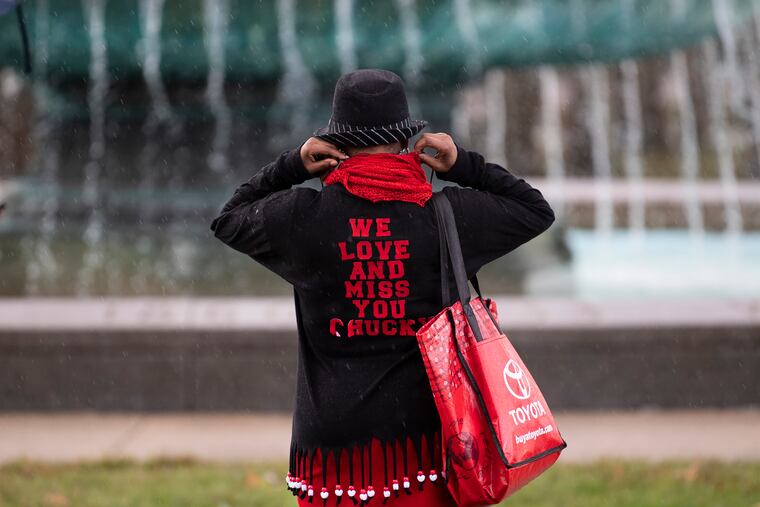AIDS Walk Philly gets smaller: ‘There is not the sense of urgency we once saw.’
Five thousand came out for the annual event, down from 15,000 about 10 years ago.

As a cold rain fell on the thousands who came out for the 32nd annual AIDS Walk Philly on Sunday morning, the conversation under the registration tent turned to weather.
One year, when it was freezing and wet, volunteers had to set up cardboard boxes to walk on or else stand ankle deep in mud, 60-year-old Mary Spear recalled.
Then there was the time West River Drive (now known as Martin Luther King Drive) was flooded, almost forcing organizers to cancel the event all together, said 62-year-old Valerie Minyard.
Spear, of Wynnewood, and Minyard, of Olney, are veterans of the walk. They walk in memory of their brothers, both of whom died of AIDS in 1996.
They remember the event being bigger in previous years. More people, more corporate sponsors, more food — Tastykakes, soft pretzels. (This year, there were bags of chips, provided by Frito-Lay, and bottles of water.) Even the walk itself has gotten shorter, going from 12 kilometers (7.45 miles) to five in 2014. About 10 years ago, the event regularly drew crowds of 15,000 and pulled in about $350,000 for services and education for those living with HIV and AIDS. This year, just over 5,000 participated, including people representing the black medical student group Student National Medical Association, the Tenant Union Representative Network, and the city's Health Department. The event raised $280,000.
It reflects changing perceptions of the disease, said Robb Reichard, executive director of the AIDS Fund, which organizes the walk.
People mistakenly equate medical advancements, such as medications that significantly lower the rate of transmission between a person who has HIV and someone who does not, with the end of the epidemic, he said. In turn, the disease has become more invisible.
It's also made it harder to raise money, which in part goes to community organizations such as Philadelphia Fight, Action Wellness, and the Mazzoni Center, providers of emergency financial support for those living with HIV.
"There is not the sense of urgency we once saw," said Reichard, 54.
It's possible that will change, in light of the opioid crisis that is ravaging Philadelphia. New data show a spike in infections among people who inject drugs. From September 2017 to August 2018, the city Health Department identified 46 newly diagnosed cases of HIV among people who inject drugs, representing a 48 percent increase over the previous 12 months.
In a blog post, the Health Department said the opioid crisis is likely to blame. The effect of fentanyl, the synthetic opioid that has killed more Philadelphians than any other opioid, lasts for a shorter period of time than that of heroin, which means that those using fentanyl might be injecting more frequently and increasing the likelihood of sharing used syringes.
Still, the Health Department says it's too soon to tell whether there's a new wave of HIV infection in Philadelphia.
There are 30,000 people in the Philadelphia region living with HIV, according to the AIDS Fund. The rate of new infection in the region is three times the national average, which Reichard says is common for places such as Philadelphia with high rates of poverty.
Men who have sex with men are at the greatest risk for infection, according to the U.S. Centers for Disease Control, and African Americans are the most affected racial group.
As medical treatments have evolved and HIV no longer becomes the "death sentence" that walk veterans such as Spear and Minyard remember it to be, the goals of the event have changed, too: Reichard talks about getting to zero — zero new infections, deaths, and stigma.
"We have to stop judging people," Reichard said.
Sunday morning a trio of protesters bearing a "Homos Go to Hell" sign and a bullhorn settled in by the snack tent. Teenage volunteers greeted them by shaking pom-poms and cheering for participants.
And even though the walk has gotten smaller, Spear said the "spirit and dedication has not changed."
Minyard agreed. By then, the rain had cleared up.
"There's still a lot of heart," she said.